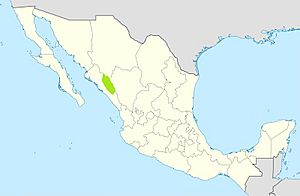Acaxee Rebellion facts for kids
Quick facts for kids Acaxee Rebellion |
|||||||
|---|---|---|---|---|---|---|---|
| Part of the Mexican Indian Wars | |||||||
 A map of Mexico showing the location of the Acaxee in Sinaloa and Durango states. |
|||||||
|
|||||||
| Belligerents | |||||||
| Spaniards | Acaxee Tepehuanos Xiximes |
||||||
The Acaxee Rebellion was a major uprising against Spanish rule in Mexico. It was started by the Acaxee people in 1601.
The Acaxee People
The Acaxee people spoke a language from the Uto-Aztecan family. They lived in the mountains and deep canyons of western Durango and east-central Sinaloa. This area was east of the modern city of Culiacan. Their land stretched about 125 miles north to south and 50 miles east to west. The Spanish called this region Topia and Tepehuana.
The Acaxee and their neighbors shared many cultural traits. They grew crops like corn, beans, squash, chilies, and cotton near their small villages. They often fought wars, and they worshipped many gods and idols. They also had spiritual leaders called shamans. Their political system was not centralized. Elders led during peacetime, and war leaders took charge when dealing with outsiders.
When the Spanish first arrived in the late 1500s, the Acaxee lived in many scattered villages. This might have been what was left of a more organized society. Many Acaxee had died from diseases earlier in the 1500s. Big outbreaks of sickness happened in 1576-1577, 1590, and 1596-1597. By the time of the rebellion, only a few thousand Acaxee were left. Their ability to fight the Spanish was also weakened because they were often at war with their neighbors, the Xixime and the Tepehuan.
The Spanish Arrival
The Spanish found silver in Acaxee lands in the 1580s. They set up several mining camps there. Hundreds of Spaniards, along with African and Indigenous slaves and workers, moved into Acaxee territory. The Spanish needed more people to work in their mines. They used a system called encomienda to force Indigenous people to work for them. However, the Acaxee lived in many small, spread-out settlements. This made it hard for the Spanish to gather them for labor.
Jesuit missionaries helped the Spanish gather the Acaxee into larger towns. This Spanish plan was called "reductions." Its goal was to Christianize the Indigenous people, control them, and use their labor. In the 1590s, the Spanish had learned that missionaries could help calm down the northern areas of Nueva Espana. The Jesuits were new to Mexico, and their work with the Acaxee was one of their first big missionary efforts.
In 1600, a missionary named Hernando de Santarén visited the region. He was with a Spanish leader named Captain Diego de Avila. Together, they made the Acaxee agree to Spanish demands. These demands included moving to new places chosen by the Spanish. They also had to build churches, cut their long hair, wear Spanish clothes, and destroy their religious images. In return, the Spanish promised to protect them from enemies. They also offered tools, seeds, and schools. However, Indigenous people who did not follow these demands were often beaten.
The Rebellion Begins
An Indigenous leader named Perico started the rebellion in late 1601. He used a mix of Spanish and Indigenous religious ideas. He told his followers that they could get rid of the Spanish. He promised a new time where their old ways would return. The rebellion aimed to bring back the Acaxee's traditional way of life and beliefs. These had been destroyed by the Spanish takeover.
In the first few weeks, the Acaxee attacks killed about 50 Spaniards. The Acaxee burned Spanish mining camps and buildings. They destroyed 40 churches. They also surrounded 40 Spaniards in a church at San Andres. This siege ended when more Spanish soldiers arrived from Durango. The priest Santarén tried to make peace, but several people in his group were killed. Another peace group led by a bishop also suffered losses.
The Acaxee took strong positions in the mountains. They stopped most silver mining and other Spanish activities in their homeland for almost two years. In 1603, the Spanish gathered an army. This army included Spanish leaders and their Indigenous allies. They defeated the Acaxee. Perico and 48 other Acaxee leaders were executed. Others were sold into slavery.
After the war, the Jesuits gained even more power. They forced the Acaxee into a few settlements. They chose the Acaxee leaders. They also tried to educate Indigenous children and keep them away from their parents' influence. In 1607, a smallpox disease spread. At the same time, Halley's Comet appeared, which was seen as a bad sign. These events seemed to end most of the Acaxee's independence. However, some Acaxee joined the Tepehuán Revolt in 1616.
Images for kids
See also
 In Spanish: Rebelión acaxee para niños
In Spanish: Rebelión acaxee para niños


